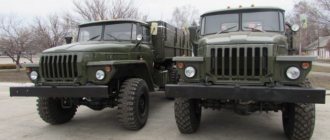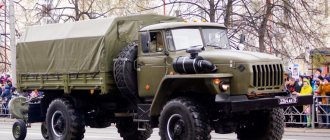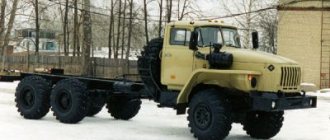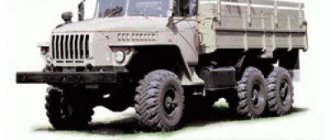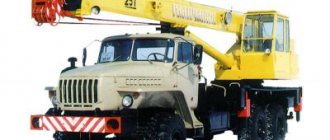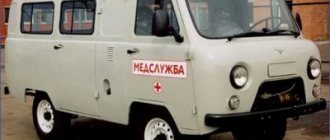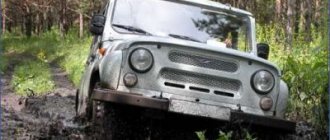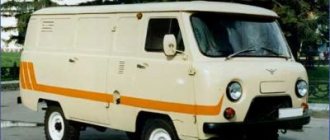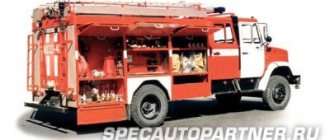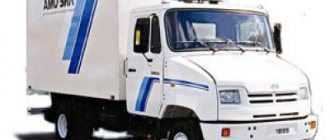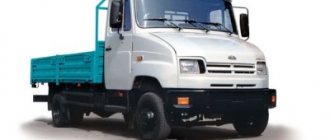The basis for the Ural-5557 model was the Ural-4320 three-axle off-road truck. The main distinguishing feature of the Ural-5557, which distinguishes the car from the 4320th model, is its low-profile wide tires. Ural-5557 initially had not a military purpose, like most UralAZ trucks, but a predominantly civilian purpose. This is an agricultural dump truck and tractor. A 6x6 off-road truck capable of operating on soft, sandy, waterlogged and swampy soils, as well as on virgin snow. In total, more than a hundred types of all kinds of special equipment were created on the basis of the Ural-5557 chassis.
About the history of the model
Small-scale production of Ural-5557 began at the Ural Automobile Plant in the city of Miass in 1983. In 1984, mass serial production of this model was launched. It continued until 2015, when standardized cabs of the GAZ Group and the main model began to be installed on the Ural chassis.
Over the years of production, the model has been modernized. So, in 1993, with the advent of the modification Ural-55571, the standard carrying capacity of the vehicle was increased from seven to ten tons, and heating of the bottom of the cargo platform with engine exhaust gases was introduced. An anti-lock brake system (ABS) became standard on the truck. Also in the mid-90s, a wide bumper with headlights appeared on the Urals-4320 and -5557, and plastic plugs appeared in the wings, at the old headlight mounting points. However, for the needs of the Ministry of Defense, they continued to produce cars with a narrow bumper and headlights in the wings.
Mid 80's.
Since 2002, UralAZ switched to producing cars and chassis with engines that only meet environmental standards not lower than the Euro-1 standard (except for vehicles intended for delivery to the Ministry of Defense of the Russian Federation). In the same 2002, the Ural-55571-44 modification debuted with a modernized cabin, which received a solid windshield with improved visibility, modern-shaped mirrors and new brackets.
Early 2000s.
The history of the 5557th model continues with the release of a new car of the Ural Next family - Ural-5557-6121-74. In 2014, the Ural Automobile Plant presented a pre-production version of the Ural, and in 2015, serial production of the Ural-5557-6121-74 (Ural Next) began.
Modifications of Ural 55571-30 chassis:
Ural 55571-1121-30 chassis Dump truck chassis with a spare wheel holder (STR) behind the cab and with a power take-off (PTO)
Ural 55571-1221-30 chassis Dump truck chassis with a spare wheel holder (SRT) behind the cab and with a power take-off ( KOM)
Ural 55571-1252-30 chassis Dump truck chassis without spare wheel holder (SWD), special design, with additional power take-off (DOM)
Chassis URAL 55571-30 with a 6x6 wheel arrangement and a load capacity of 12 tons.
Specifications
Ural-5557 - dump truck-tractor for agricultural purposes has an all-metal body with unloading in two directions. The machine's hydraulic system consists of a three-stage telescopic cylinder, a platform lift distributor, hydraulic cylinders and a side lift distributor. The system's oil tank with a capacity of 46 liters is filled with I-12A oil.
Engines
The main power unit for the Ural-5557 is the YaMZ-236 diesel engine, in the YaMZ-236NE2 and YaMZ-236M2 modifications. These are six-cylinder V-shaped engines with a displacement of 11.15 liters and a power of 180 and 240 horsepower; four-stroke, with direct fuel injection and compression ignition, without turbocharging (M2) and with turbocharging (HE2), liquid-cooled, with mechanical speed control.
- YaMZ-236M2 is the base diesel engine of the family of six-cylinder V-shaped diesel engines produced by the Yaroslavl Motor Plant. It is interchangeable with YaMZ-236M engines (produced until 1988), and with YaMZ-236 (produced until August 1985). In addition to trucks, such motors were also used as part of the power plants of KS-4372V and KS-5871 cranes, diesel gear units and marine diesel generator sets. Power 132 kW, or 180 hp, at a speed of 2100 rpm. Maximum torque – 667 N.m, or 68 kgf.m. Frequency at max. cool. torque - 1250-1450 rpm. Minimum specific fuel consumption – 214 g/kWh (157 g/l.h.)
- YaMZ-236NE2 - diesel engine with turbocharging, liquid cooling, liquid-oil heat exchanger, mechanical speed controller, with intermediate cooling of charge air in an air-to-air heat exchanger installed on the product. It was designed for the chassis of MAZ and Ural vehicles. Power 169 kW, or 230 hp, at a speed of 2100 rpm. Maximum torque – 882 N.m, or 90 kgf.m. Frequency at max. cool. torque – 1100-1300 rpm. The minimum specific fuel consumption is 197 g/kWh (145 g/l.h.).
"YAMZ-236NE2"
The Ural-5557 vehicles were also equipped with classic KamAZ diesel engines KamAZ-740 - four-stroke, eight-cylinder, V-shaped, with a working volume of 10.85 liters. The modification intended for the Urals (as well as for ZIL-133GYA trucks) is KamAZ-740.1000403. Power – 154 kW, or 210 hp. Maximum torque – 667 N.m (68 kgf.m). Frequency at max. cool. torque - 1600-1800 rpm. The minimum specific fuel consumption is 211 g/kWh (155 g/l.h.).
Differences from the classic KamAZ engine: oil pan; oil intake; fluid coupling and crankshaft cover; no backstage; large generator G288-3701; intake manifold; thermostat box.
Urals-5557 with KamAZ engines were produced until 1993, before the great fire at the . Further, they were equipped only with Yaroslavl YaMZ-236 diesel engines.
In the 2000s, modern diesel engines YaMZ-536, YaMZ-65654, YaMZ-353622, which already met Euro-4 standards, also began to be installed in the Urals of this model. The chassis with new engines received the names Ural-5557-60, 70, 80.
Unlike classic Urals with gasoline internal combustion engines, diesel Urals received an extended engine compartment. In general, it is the same for vehicles with KamAZ engines and engines from the Yaroslavl Motor Plant. A small difference - for trucks with YaMZ, the air filter is located on the right wing (due to a different, more dense layout of the engine compartment).
Fuel consumption
The fuel system on Ural cars serves for cleaning and uninterrupted supply of diesel fuel to the combustion chambers of the internal combustion engine available on the car.
For these purposes, a network of pipelines, coarse and fine filters, fuel pumps and other fuel units were installed.
A special feature of the Ural-5557 vehicle is that it does not have a fuel heating system from antifreeze circulating in the cooling system. Diesel fuel is poured into a tank with a capacity of 200 liters.
One of the most important technical characteristics of engine operation is fuel consumption per 100 kilometers.
The guidelines for modifications of the base Ural-5557 vehicle are the following indicators:
- when driving a car without a trailer at a speed of 40 km/h, the consumption should be 27 liters per 100 km;
- if the speed of a single car is 60 km/h , then the consumption corresponds to a value of 37 liters;
- if this vehicle is traveling with a trailer at a speed of 40 km/h, the consumption should be 35 liters per 100 km;
- when such a road train maintains a speed of 60 km/h , then the consumption is 41 liters.
The listed parameters correspond to a new car that has been run-in and is moving along a track with artificial turf.
In all other cases of vehicle condition and environmental conditions, there are fuel consumption standards corresponding to these conditions:
- When operating in winter, fuel consumption can increase from 5 to 15 percent depending on the amount of snow and air temperature.
- When traveling on roads of I, II and III categories, depending on the height of the relief, fuel can be spent 5-20 percent more, starting from an altitude of 300 meters relative to sea level.
- Consumption increases on cars with high mileage and number of years of operation. So, for cars operating for more than 5 years it is 5%, and for cars 8 years or more – 10%.
- Difficult climatic conditions, as well as roads of IV and V categories increase fuel costs by 50 percent.
Transmission and axles
All modifications of the Ural-5557 were equipped with manual transmissions. These are Yaroslavl five-speed gearboxes of the YaMZ-236U model. Gears 2, 3, 4, and 5 are equipped with synchronizers. Torque from the engine to the transmission elements is transmitted through a friction, single-disc, dry clutch with a diaphragm spring. The clutch drive is with a pneumohydraulic booster (PGU). Clutch model – YaMZ-182.
The mechanical two-stage transfer case is equipped with an interaxle cylindrical locking differential. It distributes the force between the front axle and the rear bogie in a ratio of 1:2. The drive to the front axle is permanent. Gear ratios: top gear – 1.21; Lowest gear – 2.15. The final drive is a through type with a gear ratio of 7.32. The main gear is double, through-type, and consists of a pair of bevel gears with a spiral tooth and a pair of cylindrical helical gears. The main gears of all truck axles are interchangeable. The differential is symmetrical, conical, with four satellites.
The cardan transmission is open with four shafts, with hinges on needle bearings. The housing of each drive axle is combined, consisting of a cast middle part and axle shaft housings pressed into it. Steered front axle - with disk-type constant velocity joints.
Chassis
The front suspension of the truck is dependent, on two semi-elliptic springs, which work in conjunction with hydraulic telescopic shock absorbers. The rear suspension is also dependent, on two semi-elliptic springs and springs.
The service brake system is drum type, with a pneumohydraulic drive. The auxiliary braking system is a compression engine retarder with elements that are mounted in the exhaust system. The parking brake is a drum mechanism on the transfer case output shaft. Disc wheels are equipped with pneumatic, tube tires with adjustable pressure 1200x500x508 156F ID-284.
Wheels and tires
Wheels for Ural-5557 are disc type. Rim 400G-508. Wide-profile tires, pneumatic tube tires, with adjustable pressure, 1200×500x508, mod. ID-P284 (or 390/95R20 147J). It is also possible to install tires of the I-247 model.” The air pressure control limits are in the range of 3.5-1.5 kgf/cm. sq. A short-term decrease in pressure to 1.0 kgf/cm is also allowed. sq. – to overcome particularly difficult areas.
Dump truck hydraulic equipment
The hydraulic system of the Ural-5557 dump truck includes a three-stage telescopic hydraulic cylinder, a platform lift distributor, a side lift hydraulic cylinder, a side lift distributor, an oil tank, and hydraulic outlets for the trailer. The control is carried out by a hydraulic drive, using a remote, electro-pneumatic type. The hydraulic oil tank is designed for 46 liters.
Electrical equipment
Like most truck models, the Ural-5557 has a single-wire wiring diagram with a rated on-board voltage of 24V. The sources of electric current are two series-connected batteries of type 6-CT-190 and a conventional or sealed generator with a power of 1000 W. To start the engine, a remote-controlled starter with an electromagnetic retractor relay with a power of 8.2 kW (11.5 hp) is used.
Dynamic characteristics:
- maximum speed – 75 km/h;
- minimum speed – 2 km/h;
- braking distance at a speed of 40 km/h – 17200 mm.
The fuel tank holds 200 l. Fuel consumption guidelines for the basic version are 27 l/100 km at a speed of 40 km/h, 37 l/100 km at a speed of 60 km/h. When driving with a trailer, consumption increases by 4-6 liters. In winter, fuel consumption increases by 5-15%.
The truck is capable of fording a ford up to 700 mm deep. The maximum climbing angle on rough terrain is 40 degrees.
The recommended tire type is I-247B or ID-P284.
URAL
URAL 3255-0010-41 (shift 22 places; YaMZ-236-NE2)23011,1534,2DURAL 32552-0010-01 (shift 23 places; YaMZ-236 M2)18011,1528,9D| URAL trucks up to 2008 | ||
| Model | Fuel consumption rate, l/100 km | Type of fuel |
Device
Ural 5557 was created for agriculture. Initially, the model was produced as a chassis with a classic 3-seater cabin without a sleeping bag. A dump platform was mounted on it, after which additional equipment was installed. The chassis itself was made of durable materials and was highly reliable. The platform was secured using quick-release connections. Unloading could be carried out in both directions. The folding of the side during lifting occurred automatically; closing was carried out using hydraulic cylinders controlled from the cabin. Extension sides with automatic closing and opening and a canopy were also installed on the platform. They were intended for more complete use of the body (helped with the transportation of agricultural products with a small specific gravity). Thanks to the canopy, cargo loss during unloading was reduced. The platform was controlled using a complex hydraulic system, including a 3-stage telescopic cylinder, a tank, a distribution unit and a hydraulic cylinder for raising the side. It made it possible to control not only the platform, but also the trailer. The hydraulic drive control is based on electropneumatics.
To increase cross-country ability, tires with a wide and low profile were installed on the car. Another feature was the centralized adjustment of tire pressure. Due to this, the Ural 5557 confidently moved through water obstacles, drove through ice, swamps, snow and off-road conditions.
The truck was equipped with a dependent spring front suspension with 2-way shock absorbers. The rear suspension was dependent on semi-elliptic springs with shock absorbers and springs.
Braking was performed using a 2-circuit pneumatic-hydraulic brake system. Through it, separate braking of the rear and front axles was performed.
The basis for the car was a reliable 5-speed manual transmission. The car could carry quite a large load. Similar performance was achieved through the use of a 2-disc clutch in the transmission. Performance characteristics were also improved due to a double unified final drive and a 2-speed transfer case. Properly selected gearbox ratios made it possible, if necessary, to move at a speed of 2 km/h without failures.
In addition to the standard cab, other options were offered. Thanks to the high placement and good visibility, an acceptable level of driving comfort was achieved. At the same time, the car’s interior was borrowed from the Ural 4320 model. Inside, a similar dashboard, shelves for things, sensors and indicators appeared.
The design of the Ural 5557 has been modernized several times. Small updates are still happening. New versions retain the advantages of the original model, including:
- high traction characteristics in difficult road and field conditions;
- possibility of operation at temperatures from -45 to +45 degrees;
- the presence of an alternating current generator with a non-contact voltage regulator and a rectifier unit, characterized by an increased service life;
- high level of cross-country ability without a strong destructive effect on the ground;
- unification of most units and components, reducing costs of production, use and maintenance.
Dimensions of the basic version:
- length – 4700 mm;
- width – 2500 mm;
- height (in the cabin) – 2650 mm;
- maximum body height – 3500 mm;
- ground clearance – 360 mm;
- minimum turning radius – 10800 mm.
The vehicle's carrying capacity reaches 7,000 kg, the maximum carrying capacity of the towed trailer is 11,500 kg. The total weight of the vehicle is 16300 kg. Weight distribution at maximum load: 4300 kg on the front axle, 12000 kg on the rear axle. The body area of the model is 10.3 square meters, volume is 17.5 cubic meters. The time for raising a loaded platform is 15 seconds, the duration of lowering is 20 seconds.
Distribution of masses and loads
- Load capacity – 7000 kg;
- Curb weight without extension sides – 9075 kg;
- Load – front axle 4306 kg, rear bogie 11900 kg;
- Gross vehicle weight – 16300 kg;
- Load at full weight - front axle 4300 kg, rear bogie 11900 kg;
- The total weight of the towed trailer is 11500 kg;
- Permissible total weight of the road train – 27500 kg;
Cabin
The all-metal three-seater cabin, located behind the engine, is equipped with thermal and noise insulation, and is attached to the frame at four points through rubber cushions. The cabin is equipped with a pneumatic windshield wiper, windshield washer and heater.
The windshield wiper is included in the car's pneumatic system. It consists of a pneumatic motor with a spool valve and a mechanism for laying brushes along the lower edge of the glass, two brushes, rods and brush drive levers.
The cabin doors are equipped with locks and mechanical windows. The driver and passenger seats are separate and are cushioned using rubber belts and sponge rubber. The driver's seat can be adjusted by moving it forward or backward. The adjustment limit is 90 mm. Also, the backrest of the driver's seat has an angle adjustment.
The cabin is heated by air heated in the heater, which is included in the engine cooling system. When the heater fan is turned on, air coming from outside through the hatch or from the cabin through the hatch is pumped through the heater radiator and enters the air heating distributor, from where it is distributed throughout the cabin by means of controlled dampers. The dampers of the air heating distributor are controlled by a lever. When the lever is in the upper position, air flows through the deflector to blow on the windows, and when it is in the lower position, it is used to warm the feet of the driver and passengers.
The cabin is ventilated through the hatches of the heating system and the openings of the lowering and turning windows of the cabin. If natural ventilation is insufficient, the heater fan turns on.
The tail of the car consists of an alligator-type hood with a lift angle of 90°, sidewalls, wings and radiator trim. For ease of maintenance of the engine and its components, the mudguards are removable. The hood is mounted on two lever mechanisms with balancing springs, which securely hold it in an upright position. Oval holes for fastening mechanisms allow you to adjust the position of the hood relative to the cab. If necessary, the hood can be secured in the raised position using the safety hook located in the left lever mechanism.
Catalog of spare parts for URAL-55571-40 (55571-40):
Our catalog contains all spare parts used in URAL-55571-40.
Select the node you need. To make it easier to find spare parts for URAL-55571-40, you can use the quick filter. Quick Filter by nodes:
- Body
BodyCabin assembly
- Lever seals and cab floor mats
- Windshield wiper and its drive
- Cabin doors
- Driver and passenger seats
- Cabin ventilation and heating
- Radiator trim
- Platform
- Overframe
- Engine
Engine
Engine mount
- Crankcase ventilation
- Installation of preheating system units
- Pipes and hoses of the preheating system
- Pre-heater boiler
- Pump unit supercharger
- Fuel pump pump unit
- Main fuel tank
- Exhaust system
- Cooling system radiator
- Clutch
Clutch and brake pedal drive with pneumatic hydraulic control
- Installing the gear shift lever
- Transfer case housing and suspension
- Cardan transmission
- Front axle housing
- Differential and axle shaft of the middle and rear axle
- Main gear drive through shaft
- Frame, bumpers and engine mudguards
Car frame
- Front suspension
- Wheel and tire
- Steering control
Steering
- Service brake
- Electrical equipment
Electrical diagram
- Dashboard
- Saddle device
Towing device for car 55571-40
- Power take-off
- Tools and accessories
Installing the tool box and oil tank
Spare parts diagrams and components are presented on the website for reference purposes! We do not sell all spare parts for URAL-55571-40 presented in this list, but many of them.
Modifications
A large number of modifications have been created on the truck platform for different tasks. There are even unusual configurations, for example, an army armored truck. The most common configurations of the Ural-5557 will be listed below.
| Dump truck Ural-55571-40 | The truck has the function of unloading the rear sample on the platform of the original machine. It is used to transport construction waste, sand, soil and other construction materials. The main difference from the unique vehicle is the increased carrying capacity of the vehicle by 3,000 kg. |
| Fire engine | Fire truck Ural. This truck is a modification of a unique model represented by the 3-bridge automobile tank AC 5.5 40. It is used to extinguish fires. It has characteristics that are almost in all respects similar to those of the standard version. The overall dimensions were slightly changed (length – 8,000 mm, width – 2,500 mm and height – 3,400 mm). There is an installed fire installation, which makes it possible to store 6 cubic meters of water. There is also a foam block designed for 360 liters. The pump is capable of flowing 40 l/sec. and more. |
| Dump truck Ural-55571-44 | From the very beginning, the machine was in the dump truck version, but today the 55571-44 configuration is used as a dump truck version. Its dimensions are as follows: length is 8,170 mm, width is 2,500 mm and height is 3,275 mm. The power unit is used YaMZ-236NE2. The car has a double all-metal cabin with a sleeping bag. |
| Ural 5557-10 | To make the machine more convenient to use for rural needs, the 5557 model is in some cases equipped with a hydraulic body lifting mechanism, which at the same time provides the ability to unload on both sides, which is extremely convenient for bulk materials. Most often you can find mechanisms of the Ural-5557-8603043 model. A model with a similar device is called an “agriculturalist”, and the most popular is the Ural-5557-10 model, which weighs 6,745 kg and has a load capacity of 16,500 kg. |
Advantages and disadvantages
The advantages of the Ural-5557 car include:
- Good cross-country ability;
- A large number of possible modifications;
- The car is perfect for agricultural work, as it can move very slowly, keeping up with and without being ahead of the harvester;
- All-wheel drive system;
- Powerful wheels;
- Ability to work in various climatic conditions and off-road conditions;
- Opportunity to purchase a used car at an affordable price;
- High ground clearance;
- Good maintainability;
- Availability of necessary spare parts;
- Inexpensive parts.
There are also disadvantages, and they are:
- High fuel consumption;
- Often breaks;
- In winter the cabin can get quite cold;
- Poor visibility.
Ural 5557 owner reviews
- Yuri, Primorsky Krai. I bought this truck because I have wanted it for a long time. The car is more for the soul than for work. Model 1991 release. Initially, the choice fell on Kraz, but at the most unexpected moment I came across an ad on the Internet with this handsome guy. The car turned out to be relatively inexpensive. The first owner had a loud knocking engine, and had no desire to repair it. So the owner decided to sell, and at the same time he gave in well. It’s better for me, I was happy to repair the car. I restored the truck myself. I dragged the truck home on a rigid hitch, there was no other way. I then immediately set about reviving the car. Long story short, it took me three months to recover, but it was worth it. As a result, I got a good farmer, capable of ironing any dirt and going through ruts and deep snowdrifts, fords and holes. Moreover, this truck became a source of income for me. The car is equipped with a KAMAZ engine that works like a clock. The power is 210 horsepower, which is quite enough for a nine-ton truck. Fuel consumption is around 40 liters per 100 km. The turning radius is 12 meters. The car rushes no worse than a tank. The landing is spartan, this is not surprising. The car's handling is beyond words. In other words, you need to feel the car, or it’s easier to get used to the frightening rolliness in corners and high fuel consumption. In general, this is the monster I dreamed of.
- Alexey, Ryazan. This is not the first year I have been working on the Ural-5557 truck. The machine was originally in a modification that was intended for agriculture. Then they rebuilt the car for dissolution. The car moves well along forest paths, but it constantly breaks down. Because of this, the truck regularly requires repairs. But on the other hand, the design is quite simple, and all spare parts are available. At first there were no problems with the engine, but after 20 thousand kilometers the diesel fuel went into the sump. This was the reason for the purchase and installation of a new injection pump. To thoroughly verify the serviceability of the injectors and pump, we checked them in three different auto repair shops - everyone said that the parts were in perfect condition. I turned off the pump lubrication system and repeatedly checked the return pipe - it was dry. In general, I decided to experiment a little - I added fuel to the pump, and as a result, the car began not to drive, but to roar like a tank, as if mad. The dynamics have improved significantly, but fuel consumption has increased - the maximum is 70 liters that I saw. Fortunately, I do not work for myself, but for a company that fully covers fuel costs. As for the transmission, it is in perfect order, but the second and third speeds work with great effort. The third one completely flies out when the car is under tension. I do not rule out that sooner or later the box will have to be removed, disassembled and repaired. But everything has its time. Brakes are a separate issue. The truck brakes very weakly. It may have to be remade for air. Although this pleasure is not cheap. The frame structure is very strong, but in some places it is already bursting, perhaps due to overload.
- Vadim, Udmurtia. There’s not much to say about this truck, as soon as I saw it I was a winner! Indeed, this car is made for winners. She is not afraid of any obstacles. This is a real off-road monster. I bought a car from the previous owner, the car is equipped with a YaMZ-236M2 diesel engine, which develops 180 horsepower and produces a torque of 665 N/m. Fuel consumption is 40-45 liters per 100 km. I have an agricultural version with very great potential. The car is equipped with all-wheel drive and a five-speed manual transmission. The model was produced in 1995, the current mileage is 120 thousand kilometers. It is useless to renew a rusty body - it will instantly become covered with corrosion anyway, so I make do with putty. Cosmetic repairs are enough. The cabin is comfortable for three people, and in winter you can turn on a powerful heater that effectively warms the cabin. The engine is very noisy, but has excellent traction.
- Pavel, Yaroslavl. I have a used Ural 5557 2010 model year. I’ve been working on it for five years, I bought the car in 2013 from the first owner. Now the mileage is 85 thousand kilometers. The car is very reliable and comfortable, it is ideal for agricultural needs. I note the high load capacity and large wheels, as well as all-wheel drive. The model is equipped with all-wheel drive and a 6x6 wheel arrangement, which provides off-road capability with a reserve. The truck also has high ground clearance and short overhangs, which significantly increases approach and departure angles. In the urban cycle, the car consumes 35-40 liters, and off-road it turns out to be around 45-50 liters, depending on the driving pace and the complexity of the obstacles.
- Nikolay, Irkutsk. A car with a diesel engine with a capacity of 180 horsepower. At one time, I had the pleasure of driving Kamaz vehicles, which are easier to maintain, and I disassembled and reassembled Kamaz engines. The Yaroslavl motor is more reliable, but more ancient. Although it is less problematic to use. It has better low-end traction. In addition, it has virtually no factory defects. Therefore, I am confident in its reliability. The engine does not require major investments in maintenance. The Ural 5557 is equipped with an engine produced by YaMZ; it starts perfectly in cold weather thanks to the presence of a pre-heater. This option is very useful, but it often fails or is completely disabled by accident. Without it, it is difficult to warm up the engine in winter at low temperatures. And the operating temperature of an internal combustion engine, as is known, starts at 70 degrees and more. By the way, I have a version with an 8-cylinder engine, which confidently drags even uphill, into a ford and through deep snowdrifts.
- Rinat, Novosibirsk. Ural-5557 has many advantages, and there are clearly more of them than disadvantages. I’ll tell you briefly about the disadvantages - those who don’t get used to the truck will constantly complain. But I’m used to it, and some of the disadvantages can be compensated for by undeniable advantages, among which I’ll note excellent maneuverability and versatility. The car overcomes any off-road conditions. I have an agricultural version with all-wheel drive and a YaMZ diesel engine with 180 horsepower. Model from the mid-1990s. Of course, I had to deal with some problems that seriously tarnished the reputation of the truck. We are talking about the steering gearbox, transfer case, brakes and chassis - all these components and assemblies require increased attention. Fuel consumption is 40-45 liters - it is almost the same as the old GAZ-66, which is less powerful. With regular maintenance, the car has never failed in any major way. It can be repaired even in the field, but the necessary tools must be available. Replaced seals, bearings and other rusty parts. The gearbox and other more serious components are all original and have never been changed.
- Alexander, Stavropol region. My car is Ural-5557, it has great potential in rural areas. Of course, because its carrying capacity is 15-17 tons, and its off-road capability is ensured by impressive toothed wheels with a wide profile. By the way, all-wheel drive works on all wheels - the wheel arrangement is 6x6, as befits real all-terrain vehicles. I have a 1991 model, I bought it in 2010 for work in the agricultural sector, as well as for hunting, fishing, etc. I am a country person, and I love nature, I just can’t live without it. I am drawn to the river, to the fields and forests. Therefore, the Ural-5557 is the car for me. I thoroughly studied the design of the car, which is equipped with a five-speed manual transmission and transfer case. Conversion technology was developed back in the USSR. The truck has a colossal margin of safety, although I don’t know how much longer it will last. Off-road - in the taiga, on forest paths, in the far north - the maximum fuel consumption is within 45-50 liters. This is a clear drawback, but you can come to terms with it if you evaluate other advantages. For example, cross-country ability, good visibility, high-torque engine and high maintainability.
